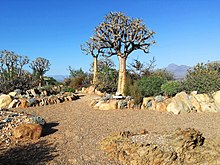Karoo Desert National Botanical Garden

The Karoo Desert National Botanical Garden ( KDNBG , German about: "National Botanical Garden of the Karoo Desert") in Worcester near the Hex River in the South African province of Western Cape is one of the state botanical gardens in the country, which is run by the South African National Biodiversity Institute (SANBI) as research and educational institutions. It was founded on July 25, 2014. After Kirstenbosch in Cape Town , it is considered the second oldest national botanical garden in South Africa.
development
This botanical garden was first created in 1921 at a different location, in the locality Whitehill , about 5 kilometers east of Matjiesfontein . At that time it had an area of about 21 hectares. Its name was then Logan Memorial Garden . Its first curator was Joseph Archer, a succulent specialist who had been working in this role since 1925.
Due to unfavorable conditions with the water supply and because of the relocation of the national road, which at that time was close, this location proved to be unsuitable after just a few years. The garden received an annual rainfall of 64mm to 185mm between 1923 and 1928 . The average was around 125 mm and maximum values reached around 200 mm per year. Therefore, the Director of Kirstenbosch began in 1944 ROBERT H. Compton along with Jacques Thudichum, one from Switzerland originating gardening expert , who from Argentina immigrated, the search for a new surface. Two locations were considered.
The decision was made in favor of an area north of Worcester, whose city administration and the privateer Charles P. Heatlie made areas available free of charge for the new construction. The new botanical garden was laid out on August 15, 1945. After further donations from the two landlords, the area expanded to 154 hectares and became increasingly known as the Karoo National Botanical Garden ( Afrikaans Karoo tuin ). Jacques Thudichum became the first curator of the new botanical garden. He was responsible for moving the Whitehill plants to the new site. His work was honored with the naming of the yellow to orange blooming Drosanthemum thudichumii , a species of the Capensis flora .
In 2001, the name was changed to Karoo Desert National Botanical Garden in order to show more clearly that plants from the desert and semi-desert regions of southern Africa are preserved and presented here.
Location and structure
The Karoo Desert National Botanical Garden is located at the foot of the Hex River Mountains , on the northern outskirts of Worcester and displays a wide variety drought resistant plants, with emphasis in the landscapes of the Karoo . Its total area is 154 hectares, of which only 11 hectares are designed for horticulture and the much larger part forms a natural area. The highest point is Die Koppe at 526 m.
Mountain landscape with quiver tree ( Aloe dichotoma )
Three hiking trails are signposted in the area of the Karoo Desert National Botanical Garden :
- Shale trail (about 1 kilometer),
- Grysbokkie trail (about 3.4 kilometers),
- Heuweltjie trail .
The spring season between July and the end of September is characterized by an abundance of flowers. In addition to other themed areas, the garden has a rich collection of succulent plants . There is, for example, the Southern Namibian Garden , a Richtersveld / Gariep Section and the Quiver Tree Section .
The water shortage in East and Southern Africa since 2015 has also resulted in restrictions for the botanical garden. Water consumption was restricted by shutting down public wells and regrouping plants according to their natural moisture requirements so that watering work can be carried out more economically. In order to take less drinking water from the adjacent municipal supply system for irrigation, recommissioning an older well is being considered.
Babiana mucronata subsp. mucronata
Plants of the Conophytum genus
The technical infrastructure of the garden also includes an administration area, a restaurant and several non-public greenhouses. In the area of the administration building there is a herbarium , a specialist library, a collection of seeds and a small assembly room.
literature
- Christopher Willis, Gideon Smith, Ian Oliver: From Whitehill to Worcester . In: Veld & Flora Vol. 92 (2006), Issue 1, pp. 34–39, online at www.pza.sanbi.org (English)
Web links
- SANBI: Karoo Desert National Botanical Garden website . at www.sanbi.org (English)
Individual evidence
- ↑ a b c d SANBI: History . at www.sanbi.org (English)
- ↑ a b SANBI: Information . at www.sanbi.org (English)
- ^ SANBI: Shale trail . at www.sanbi.org (English)
- ↑ SANBI: Grysbokkie trail . at www.sanbi.org (English)
- ^ SANBI: Environmental Awareness . at www.sanbi.org (English)
- ^ SANBI: Main Administrative Complex & Hiking Trails . at www.sanbi.org (English)
Coordinates: 33 ° 36 ′ 43.8 ″ S , 19 ° 26 ′ 59.1 ″ E













